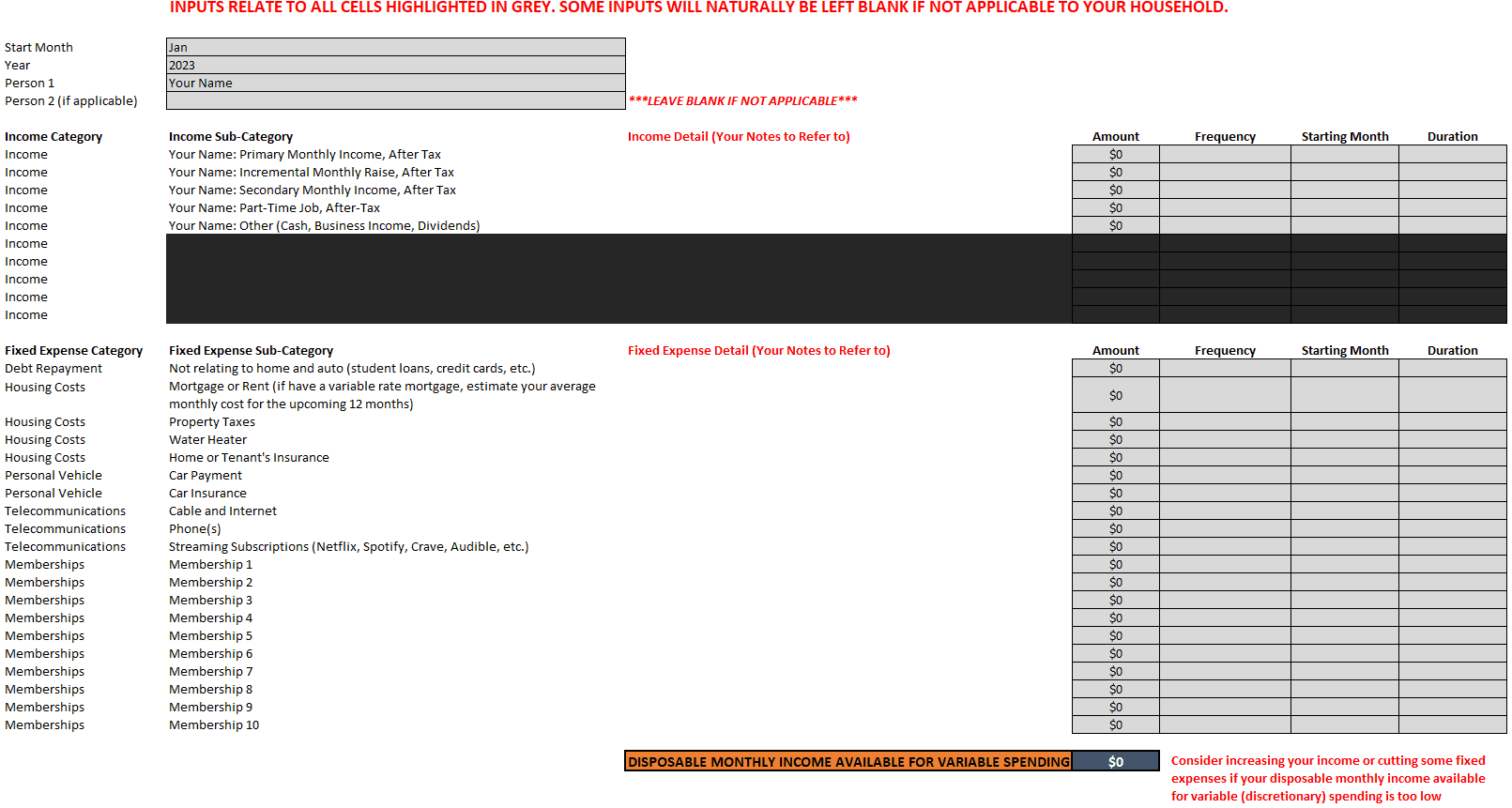Budgeting Best Practices
Key considerations for building out your budget and tracking your progress
The first step in every homebuyer’s journey is assessing their financial situation and putting together a savings plan. Without this in place, it is difficult to understand what you can afford or how you plan to get there. A budget or financial plan is all about building the right habits. By building out a proper annual budget, you can stay disciplined on your spending, better understand where your money is going, and progress towards an eventual down payment or other large savings goals.
As part of this article, there is a free budget model in Excel for you to take advantage of when creating your personal budget for the year ahead. The model is built dynamically, so try to make the timing and amount of your budget inputs as precise to your situation as possible in order to get the best results.
The First Priority is to Get Debt-Free
Before we get into it, one expense item that deserves special attention is debt not relating to an asset like your mortgage or car. Repayment of non-asset debt should always be prioritized over discretionary spending or personal investing, although too often people will do the opposite. The fact is, if you have $50K in savings and $50K in student loans, you have zero net savings and are paying extra cost in interest every month. A budgeting best practice is to pay down debt as quickly as possible, starting out with your most expensive debt (i.e. that which charges you the highest interest rate). A common example is credit card debt, which typically charges at least 20% on monthly interest but is too often ignored by consumers. If you have any level of savings but still manage to have an outstanding credit card balance that is charging you interest, your first priority should be to pay it off as quickly as possible. By prioritizing your spending to become debt-free, you will make the most of your future savings and more quickly reach your financial goals.
Map out Income and Expenses to Set Your Savings Goal
To gain value from a household budget, it is important to set a savings goal that you work towards and hold yourself accountable to. In order to set a realistic, achievable goal, you need to start by mapping out all of your expected income and expenses. No two households are the same. If you plan on using my budget template, you will see a variety of categories that may not apply to you. You may not have children, may use public transit or biking instead of a car, or may live at home as opposed to paying rent or a mortgage. Simply leave any of these categories blank and focus on the key inputs that shape your personal situation.
For all households, a budget is built around 3 main categories: personal income, fixed expenses like cell phone or rent payments, and variable expenses like entertainment and travel. As you may expect, income and fixed expenses are more structured and therefore easier to budget out. The variable categories, on the other hand, will vary by season and can throw off your savings goal if not properly accounted for. In building out your budget, start with your household income and fixed expenses. Once these more repeatable inputs are mapped out, you can get a sense how much you have available for variable spending (i.e. discretionary). This will help inform how much to allocate towards each of your variable expense categories in order to still have some money available for your savings account.
There are some best practices to keep in mind when estimating your income and fixed expenses. First and foremost, all income should be expressed on an after-tax basis. Secondly, if you expect to receive a raise or annual salary increase, this should also be accounted for. On our budget template, any incremental income from a raise can be added as a separate line-item with a starting month based on when the raise will come into effect. For fixed expenses, your payment frequency will vary, with most payments occurring monthly but others occurring quarterly or annually. By mapping out these expenses based on when they will actually occur, as opposed to smoothing them into a monthly average, you will have a more precise monthly picture of your cash inflows and outflows for the upcoming year.


Finalize Your Target Goal and Work Towards It
Once you’ve mapped out your expected income, fixed expenses, and monthly allocation for variable spending, your budget will either show a surplus (income exceeds fixed and variable expenses), deficit (expenses exceed income), or be in balance (income equals expenses). In order to save money that can be put towards a home down payment or another large purchase, the goal will be to have a budget surplus. This target surplus will vary for each person, and it is important to set a realistic and achievable goal to stay motivated as the year progresses.
If your budget inputs do not currently show a surplus, you can take some steps to improve your situation. The first thing you can do is reduce your planned spending. This is most commonly achieved by reducing your variable spending, such as lowering your monthly allocation for dining and entertainment. However, many fixed expenses can also be cut. Perhaps you and your partner don’t need to pay for two Netflix accounts, can bundle phone and internet into a cheaper package, or can swap your annual golf membership for a more affordable leisure activity. In any event, a careful review of your fixed and variable spending can yield significant improvements to your budget.
Finally, you can increase your income if your budget surplus is still not where you’d like it to be. A common example is taking on a part-time job, although there are many side hustles that can earn you a little extra cash. While more difficult than reducing your spending, increasing your income is another lever you can use when building out your personalized budget. On my budget template, you will see that you can specify a starting month and duration for each income stream you list. This is important for certain income sources that are not ongoing, such as a teacher who takes on short-term employment during the summer break, or an annual or quarterly bonus. Once you’ve finalized all income and expenses for your household for the year ahead, you will have your target savings goal (budget surplus) that you can track throughout the year.
Track Budget Progress With Your Actual Results
This part is easier said than done, and the main reason why so many households do not properly maintain a budget. Once you’ve set up your budget inputs for the year ahead, you will need to add your actual income and expenses as the year progresses. This is the most challenging part of a budget process but essential in order to derive value from the process. If your household budget includes a partner, then you will also need to coordinate with them to properly account for all income and expenses. When multiple debit and credit cards are considered, it is easy to understand why most people build a budget only to give up on tracking it a few months in.
If you do not input your actual results by month, you won’t be able to see how you are progressing against your budget, referred to as budget variance. The good news is that through online banking and a variety of spending apps, you can itemize your transactions for each month, simplifying the process. For example, with most online banking portals, you can copy all your credit card transactions in a given month and paste them into Excel into a readable format. This is much more time-efficient than manually entering each transaction when it occurs, but everyone will have their own tracking preference. The main thing is that you add every single income and expense for a given month so you can see how it compares to what you budgeted.
On my budget template, you will see an ‘Actual’ inputs page with 4 key fields per transaction: Dollar Amount, Transaction Date, Budget Category, and Sub-Category. If you believe I’ve missed a category or sub-category, use your judgment to pick the closest category or the ‘Miscellaneous’ sub-category. Alongside these mandatory fields, you can also add Transaction Detail as well as who the transaction was paid or received by, if your household includes a partner. By tracking who paid or received the transaction, you can better understand who is spending what and how best to implement lifestyle changes that work towards your shared financial goals. As a best practice, try to set aside time at the start of each month to add all your actual income and expenses. By allocating time to add all expenses from the prior period, you can avoid missing some days and also maintain your sanity throughout the year. For some people, once a week may work better, but the key takeaway is that a budget will be more accurate if you have a structured process in place.
Hold Yourself Accountable
Once you add in your actual transactions for a given month, you can see how close you were to your budgeted monthly surplus. If you did not meet your goal, you will have to make up for it in later months by reducing certain spending areas or increasing your monthly income. In any event, it is important to review this on a monthly basis to see how you are progressing towards your annual savings goal.
By analyzing your actual spend across various categories, you will have a better idea of where you can make adjustments in order to increase your savings level. Perhaps your dining and entertainment spend was well above your budgeted amount for one month due to birthdays or holiday celebrations: knowing this detail is a key benefit of proper budgeting. If you don’t hold yourself accountable, there is limited benefit in setting up a household budget. There are a variety of ways to stay motivated on this accountability component, such as rewarding yourself with a trip or new toy at year-end for the amount you exceeded your stated budget surplus.
On our budget template, you will see both a Monthly and Year-to-Date summary page to help track your progress. These pages are intended for you to review and require no inputs on your part. If you have any questions about how to use this spreadsheet or interpret the summary pages, please don’t hesitate to reach out.

Final Considerations
No budget is ever going to be perfect. Some actual expenses will be missed or incorrectly added, while some variable expenses, such as travel, are not consistent throughout the year. If you are budgeting with a partner, having a second set of eyes to review budget entries or discuss monthly projections is the best way to improve accuracy. In regards to timing, you can adjust frequency of spend (monthly, quarterly, annually, etc.) and duration (2 months, 3 months, etc.) on the Budget Inputs page to increase your overall precision for each month. Most items will simply be stated on a monthly basis, but the more accurate the budget, the more likely you will be in achieving your stated savings goal. This is why certain categories, such as Trips, Gifts, and Memberships allow for multiple different entries to better account for one-time events as opposed to a standard monthly allowance.
Whether saving up for your first home or a year-long travel hiatus, maintaining an annual budget and following best practices is a great way to reach your financial goals. Best of luck and please reach out if you have any questions or suggestions on how to improve this budget template.
FREE BUDGET WORKSHEET
Let us help you manage your budget with ease. With our worksheet, you'll be able to easily track your expenses, identify areas of improvement, and make financial decisions that help you reach your goals.

